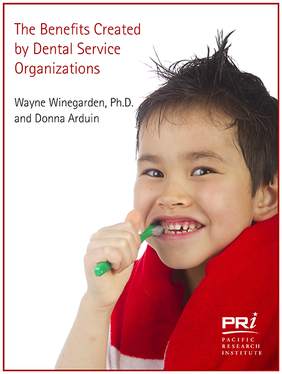New Study Finds Dental Service Organizations Disproportionately Benefit Low-Income Communities

October 15, 2012 A new analysis by the Pacific Research Institute finds that Dental Service Organizations (DSOs) create a win-win solution for consumers and taxpayers by providing important, efficient and effective health services to people who have historically lacked access to care, ultimately at a lower cost to the taxpayer. The study, The Benefits Created by Dental Service Organizations is co-authored by Wayne Winegarden, Ph.D., senior fellow of business and economics at the Pacific Research Institute and Partner at Arduin, Laffer & Moore Econometrics and Donna Arduin, President of Arduin, Laffer & Moore Econometrics.
Dental Service Organizations exemplify the types of health care benefits private sector firms can create but only if the policy environment does not impede their contributions, said Dr. Winegarden. DSOs can effectively provide dental services to lower income Americans who would otherwise not receive regular dental care.
The study finds, in part, that DSOs are an excellent example of private sector innovations that create a solution to a serious societal problem. In fact, DSOs have emerged to meet the challenge of providing conservative, low-cost dental care treatment to a previously underserved population.
Pacific Research Institutes research elaborates on the serious health effects that have emerged in many lower income communities due to a lack of access to regular dental care. A recent report from the Kaiser Family Foundation stated dental caries, or tooth decay, remains the most common chronic disease among children ages 6-18. Additionally, the incidence of this problem disproportionately affects children from lower-income families.
Lack of access to dental services is a significant problem because Medicaids reimbursement rates have been, and continue to be, too low to adequately compensate traditional dental practices. Twenty-six states Medicaid programs reimburse, on average, less than 60.5 cents of every $1 billed by a dentist. As a consequence, most traditional dental practices lose significant amounts of money when serving Medicaid patients and therefore limit the number of Medicaid patients they will serve.
PRIs research finds that DSOs are a market solution to this problem and empower dentists to serve populations that are not effectively served otherwise.
DSOs are able to have a lower cost of operations than traditional dental practices by creating operational efficiencies through innovations that lower operating costs and lower capital costs (through bulk purchases and greater negotiating power.) Additionally, DSOs lower capital risk for dentists and bring marketing and other business expertise that are not part of the traditional dentist training programs. When combined together, these benefits not only increase the overall profitability of dental practices, but also allow them to profitably serve some Medicaid patients at the current reimbursement rates.
The study also describes the DSO structure and why this model lends itself to meeting the needs of an underserved market. While it is true that not all DSOs provide care for lower income, Medicaid or CHIP eligible patients, obtaining dental care for children within this demographic remains a challenge, as many states reported that most dentists in their state treat few or no Medicaid or CHIP patients.
Finally, the study provides current developing evidence that DSOs create significant economic benefits for the dentistry profession, and providing better and more widely available dentistry services to all communities especially the lower income communities.
To read more about The Benefits Created by Dental Service Organizations”, download the PDF.

